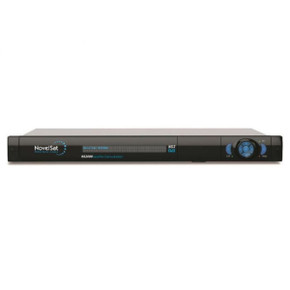
NovelSat
NovelSat SAT-SIM Satellite Channel Simulator
Request a quote at Contact@orbitalconnect.com or +1.888.218.9394
The SAT-SIM delivers practical, physics-based satellite link emulation for developers, integrators, and test labs seeking to accelerate SATCOM system validation without the complexity and cost of over-the-air infrastructure. Built on a software-defined platform, SAT-SIM enables real-time simulation of satellite RF propagation conditions, including delay, Doppler, attenuation, noise, phase noise, and linear and non-linear effects, allowing for high-fidelity, repeatable test scenarios in a controlled lab environment.
Designed to ensure performance across diverse SATCOM systems, SAT-SIM supports up to 600 MHz of bandwidth and offers both static and dynamic modeling capabilities. SAT-SIM is ideal for evaluating link performance, stress-testing modems and waveforms, and verifying end-to-end system behavior. Compact, flexible, and easy to deploy, SAT-SIM delivers reliable, cost-effective validation capabilities for engineering labs, system integrators, and mission-critical testing workflows.
SAT-SIM operates in the L-band and supports one RF channel with up to 600 MHz bandwidth, or two independent channels with up to 300 MHz each, allowing flexible simulation setups for a wide range of waveform and modem configurations. The advanced signal processing and wideband capabilities enable engineers to emulate diverse link conditions and behaviors for different waveform and modem configurations.
To support dynamic satellite modeling, SAT-SIM also integrates with Ansys STK, allowing direct use of satellite and terminal trajectory data for realistic, time-varying simulation scenarios.
In Noise Generator Mode, SAT-SIM digitally injects Additive White Gaussian Noise (AWGN) with a control range of up to 40 dB, and with a bandwidth of up to 600MHz (dual or single channel), depending on configuration. Engineers can use this feature to simulate degraded link conditions, interference environments, and signal resilience at varying signal-to-noise ratios.
SAT-SIM also includes a range of built-in tools to support comprehensive test workflows:
▪ Integrated amplifiers provide selectable 10 dB and 20 dB gain options for operating with low input signals
▪ High dynamic range input control using variable attenuators with up to 60 dB attenuation
▪ Graphical spectrum analyzer for real-time RF signal visualization and monitoring
▪ Support for both external and internal clock references
▪ Extended frequency range: while standard interfaces operate in L-band, optional front-end modules allow operation from 10 MHz to 6 GHz
With its broad configurability and advanced emulation capabilities, SAT-SIM empowers SATCOM developers to simulate, stress-test, and validate satellite system performance with precision and repeatability.
The SAT-SIM delivers practical, physics-based satellite link emulation for developers, integrators, and test labs seeking to accelerate SATCOM system validation without the complexity and cost of over-the-air infrastructure. Built on a software-defined platform, SAT-SIM enables real-time simulation of satellite RF propagation conditions, including delay, Doppler, attenuation, noise, phase noise, and linear and non-linear effects, allowing for high-fidelity, repeatable test scenarios in a controlled lab environment.
Designed to ensure performance across diverse SATCOM systems, SAT-SIM supports up to 600 MHz of bandwidth and offers both static and dynamic modeling capabilities. SAT-SIM is ideal for evaluating link performance, stress-testing modems and waveforms, and verifying end-to-end system behavior. Compact, flexible, and easy to deploy, SAT-SIM delivers reliable, cost-effective validation capabilities for engineering labs, system integrators, and mission-critical testing workflows.
SAT-SIM operates in the L-band and supports one RF channel with up to 600 MHz bandwidth, or two independent channels with up to 300 MHz each, allowing flexible simulation setups for a wide range of waveform and modem configurations. The advanced signal processing and wideband capabilities enable engineers to emulate diverse link conditions and behaviors for different waveform and modem configurations.
To support dynamic satellite modeling, SAT-SIM also integrates with Ansys STK, allowing direct use of satellite and terminal trajectory data for realistic, time-varying simulation scenarios.
In Noise Generator Mode, SAT-SIM digitally injects Additive White Gaussian Noise (AWGN) with a control range of up to 40 dB, and with a bandwidth of up to 600MHz (dual or single channel), depending on configuration. Engineers can use this feature to simulate degraded link conditions, interference environments, and signal resilience at varying signal-to-noise ratios.
SAT-SIM also includes a range of built-in tools to support comprehensive test workflows:
▪ Integrated amplifiers provide selectable 10 dB and 20 dB gain options for operating with low input signals
▪ High dynamic range input control using variable attenuators with up to 60 dB attenuation
▪ Graphical spectrum analyzer for real-time RF signal visualization and monitoring
▪ Support for both external and internal clock references
▪ Extended frequency range: while standard interfaces operate in L-band, optional front-end modules allow operation from 10 MHz to 6 GHz
With its broad configurability and advanced emulation capabilities, SAT-SIM empowers SATCOM developers to simulate, stress-test, and validate satellite system performance with precision and repeatability.














